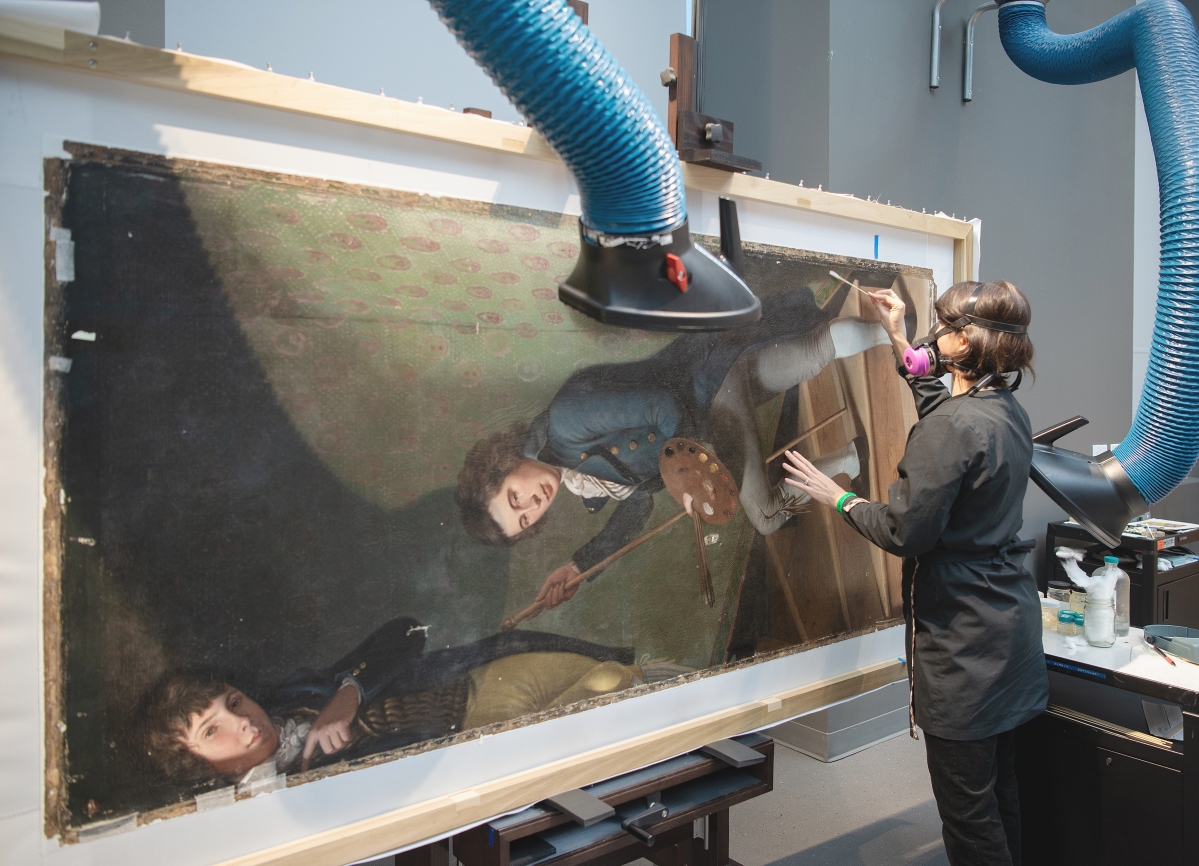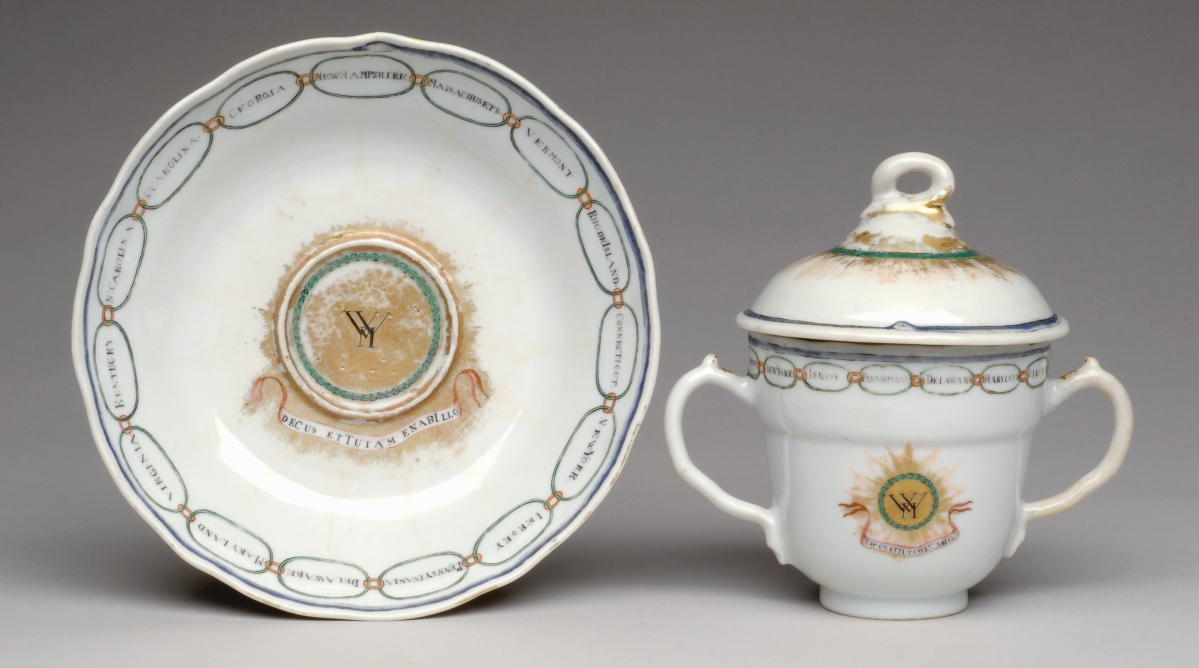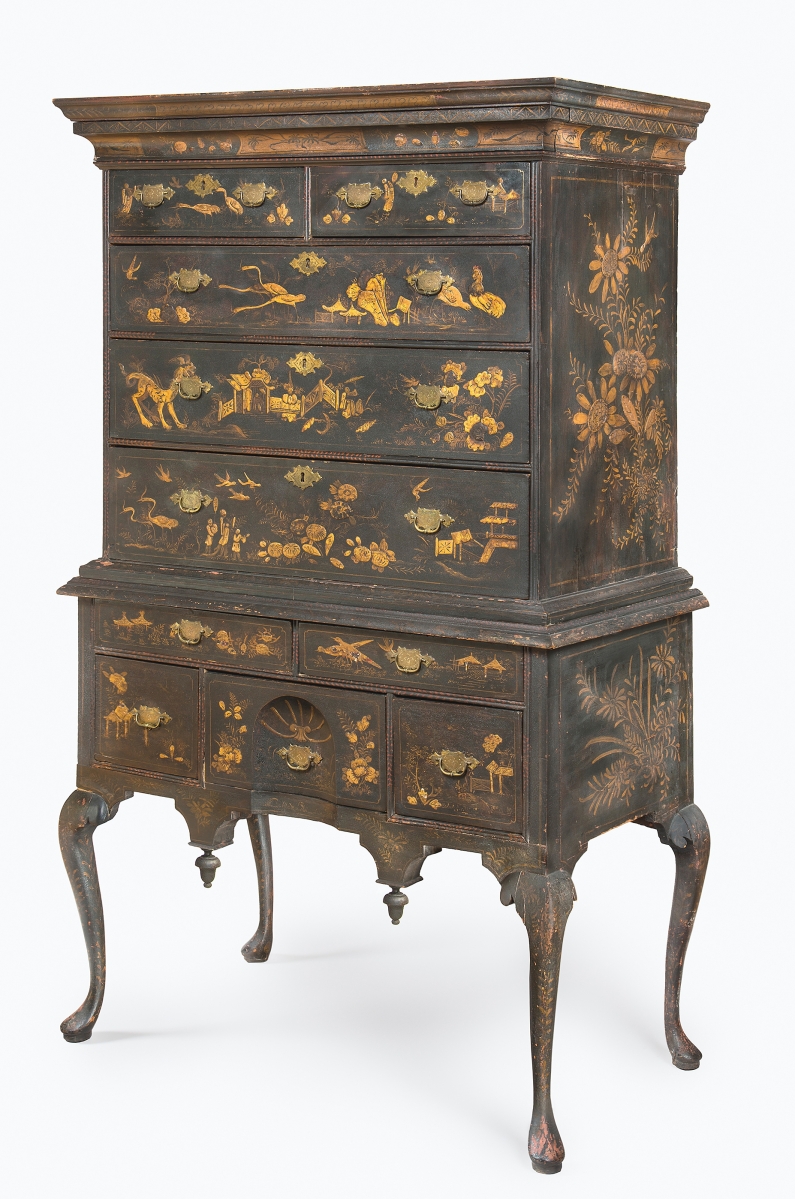
Wampum belt likely made by Lenape women artisans, 1682. Made in the Delaware Valley. On temporary loan from the board of trustees of the Atwater Kent Museum (Philadelphia History Museum), the Historical Society of Pennsylvania Collection and the City of Philadelphia.
By Jessica Skwire Routhier
PHILADELPHIA – What a time to be reconsidering the origins and development of American art. As we deal with the aftermath of a contentious presidential election and the related insurrection attempt at the Capitol in January; rising calls for social justice, not least in response to the continued killing of unarmed people of color by the police; and a pandemic that has brought both our global interconnectedness and the power and limitations of science to the fore, the art of the Seventeenth to Nineteenth Centuries might seem very remote – perhaps not the most urgent issue to parse, among so many. But that mindset overlooks two important facts: that reflecting upon our national history has been a constant and essential aspect of understanding the turmoil of the last year or so, and that the arts – both the fine and the functional – are and have always been a mirror of that history. The newly reinstalled Art of the Americas collection at the Philadelphia Museum of Art (PMA), opening May 7, takes seriously that idea of past as prologue, offering “a spotlight on immigration, colonialism, trade and underrepresented narratives.”
The new Robert L. McNeil Jr Galleries that house the reinstallation are part of a larger and ongoing building campaign overseen by architect Frank Gehry. Kathleen Foster, the PMA’s Robert L. McNeil Jr senior curator of American Art and director of the Center for American Art, remembers that it was already on the agenda when she was hired in 2002. (Foster led the curatorial team for the reinstallation, which also includes curators David Barquist, Alexandra Kirtley and Carol Soltis; project manager John Vick; and educator Rosalie Hooper, along with an academic advisory committee). Then-director Anne d’Harnoncourt had a reinstallation of the American collections in mind even then. “The American department was created in 1973, and the new galleries were installed in 1976,” Foster recalls. “There was a whole new build for those American galleries, which were state-of-the-art in 1976, and that’s the last time the galleries really had been reconsidered.” She adds that it was all “getting a little bit shopworn” and “intellectually, needed a rethinking.”
It was no accident that the earlier iteration of the PMA’s American wing debuted in 1976, a year in which cultural institutions nationwide organized celebrations in honor of the US bicentennial. The PMA’s press materials acknowledge that anniversary but elide perhaps an even more crucial one: the Philadelphia Centennial Exhibition of 1876, which had long-reaching ramifications for the history of art and museums in the United States generally, and Philadelphia in particular. Presented in concert with the 100th anniversary of the nation’s founding, the Centennial Exhibition highlighted American history and arts – from recreated “colonial” dwellings to paintings by members of the Hudson River School – but it also featured international exhibits, notably a display of Japanese art and design that caused a stateside craze for Japonisme. Although the Philadelphia Museum of Art did not yet exist – it would eventually open in 1928 – it was chartered in that centennial year. Many scholars and cultural observers, then and now, have thus pointed to the Centennial Exhibition as a crucial shift in the presentation and interpretation of art in the United States: from private to public, from isolationist to international, from ephemeral venues to permanent ones.

Lucia Bay, the Joan and John Thalheimer associate conservator of paintings, removes old varnish from the surface of “Staircase Group (Portrait of Raphaelle Peale and Titian Ramsay Peale I)” by Charles Willson Peale, 1795. Oil on canvas. The George W. Elkins Collection, 1945. Image courtesy of Philadelphia Museum of Art, 2021. Photo by Jason Wierzbicki.
It remains to be seen whether the present reinstallation will mark another cultural shift. It differs from the 1876 exhibition, of course, in that the earlier show included objects made right up to its present day, whereas the McNeil galleries have a strict cutoff date of 1850, earlier even than its predecessor. (The American collections from 1850 to 1950, Foster explains, will receive their own reconfigured treatment in a later phase of the larger building expansion/collection reinstallation campaign.) Nevertheless, there are innovations here. Fully integrating the decorative arts with paintings and sculpture is not unprecedented – other museums, like Boston’s Museum of Fine Arts, have done the same with their relatively recent American art reinstallations – but it remains a fairly revolutionary approach, representing not only a more holistic view of cultural production in the United States but also a de-Balkanization of museum curatorial departments. Similarly, and more significantly, the PMA’s newly reinstalled American collections take a broad view of what qualifies as “American” art, encompassing work by Indigenous and Latin American artisans, shedding new light on work made by African Americans, and highlighting the histories of imperialism and trade as the contexts in which these objects were made, exchanged, used and preserved.
Philadelphia and, more broadly, Pennsylvania, offer a unique milieu in which to consider the diverse nature of American art and culture, Foster says. She points to the first gallery in the reinstallation, titled American Encounters, which includes the Lenape wampum belt presented to William Penn in 1682 at the Treaty of Shackamaxon. It is displayed alongside sensitive portraits of the Lenape leaders who were later betrayed by the “Walking Treaty” negotiated with Penn’s sons, which forced the tribe to vacate the Delaware River Valley. “The wampum belt was probably made by women,” says Foster, “and wampum was inherently valuable; it’s basically currency…. So they’re weaving this image out of what is, to them, gold…and yet behind the backs of these artists we have these wheelings and dealings by the landowners.” The objects are “wonderful,” she says, but the story they tell is “not necessarily a cheerful story of American art.”
The wampum belt is a loan from the Historical Society of Pennsylvania and the City of Philadelphia, and Foster acknowledges that the PMA has relied heavily on loans to make this a more inclusive display, particularly when it comes to Native American art. “We actually don’t have a collection of Native American art at the PMA; so that’s one reason why it’s been an invisible tradition. Native American art was always deemed ethnographic…so there was a kind of a racist premise here.” She and her co-curators have attempted to remediate this not only through the inclusion of artifacts from those earliest points of contact but also by, for instance, including a Lenape beaded bag from the Kansas Territory, which represents the continuation of those displaced peoples and their cultural traditions beyond the impacts of settler colonialism. “It’s going to be front and center,” Foster says of the presence of Native American art in the installation. “It is woven into the story.”

Saucer and caudle cup with cover from a service for George Washington (President 1789-1797), 1796, designed by Andreas Everardus van Braam Houckgeest (Dutch, 1739-1801). Porcelain with enamel, gilt and underglaze blue decoration. Gift of the McNeil Americana Collection, 2006. Image courtesy of Philadelphia Museum of Art, 2021.
The exhibition proceeds in a roughly chronological format, with galleries dedicated to successive themes and areas of strength in the PMA’s collections. Global Connections offers an ecocritical look at the raw materials (silver, mahogany) that spurred the US trade in luxury goods and the colonial systems that provided the labor to supply them. Objects featured here range from early examples of Philadelphia furniture to a Mexican devotional painting inlaid with mother-of-pearl. Loyalty and Independence, with portraits by John Singleton Copley and silver by Paul Revere, documents the emergence of a distinctly American style as longstanding allegiance to British rule struggled against growing calls for revolution, both politically and culturally. Pennsylvania Crossroads highlights the twin British and German cultures that dominated 1700s Pennsylvania: the museum’s high-style Chippendale “Fox and Grapes” chest of drawers is seen aside an equally luxurious kleiderschrank, or clothes press, made around the same time in Lancaster County.
A Family of Artists celebrates Philadelphia’s own resident polymath, Charles Willson Peale, and his artistic family – a highlight here is Peale’s recently conserved, utterly unique multimedia painting “Staircase Group” – while shedding new light on the family’s collaborations with Moses Williams, a man they enslaved and ultimately freed. Splendor in the New Nation encompasses Philadelphia’s brief period as the center for American political life and, concurrently, for neoclassical design that posited the city as the “Athens of America.” Coming off of that, a special gallery dedicated to Presidential china offers a shrine of sorts for those unable to resist these plates and platters so unapologetically designed in service of American chauvinism. Fans of the genre will be relieved to know that the date limit of 1850 has been set aside in order to include the audacious Rutherford B. Hayes service of 1882.
Art & Ambition tracks the tandem development of wide-scale industry and American landscape painting, featuring objects, like a Tucker Factory porcelain vase decorated with a paradoxically arcadian view of its own manufacturing facility, that uniquely blend the traditions. Also featured here are works produced within Philadelphia’s free Black community, the largest in the United States at the time, with new research revealing names and histories forgotten or ignored by generations of previous scholars (a signed high chest by Thomas Gross deserves special mention). Finally, Traditions on the Move begins by tracking the continued artistic production of Pennsylvania’s German-speaking cultures, with fraktur drawings and redware, before coming back full circle to the themes that began the show. Here is the later Lenape bag; here, too, are Edward Hicks’ much-loved “Peaceable Kingdom” paintings. Individually and together, these works of art function as historical documents: the latter a hopeful view of a promise for peace and harmony with nature; the former an artifact of the persistence of art and beauty in defiance of that promise broken.

High chest of drawers made by John Brocas, (American, died 1740), 1733-1737. White pine, maple, maple veneer, gessoed and painted decoration, brass. Dietrich American Foundation. Image courtesy of Philadelphia Museum of Art, 2021.
This reinstallation project has been in progress for years, as noted above; however, the physical reality of moving and arranging the art took place almost wholly in the midst of this past year’s national upheaval. Still, Foster says, “The storm of 2020 certainly did not invent this installation…I think it just made it more urgent.” The reinstallation had initially been slated to open in the fall of 2020, she says, and “we were restless and eager during all of last summer. It was frustrating to us that we were not able to open and we were not able to put the show up, [because] all of the themes in the show were so pertinent to the issues in public life.” In highlighting the points of encounter between cultures throughout the 200-year period covered by the objects on view, Foster says, the show reflects “the combustible mix that has created American culture today…it’s thinking about the stresses we’re living with today as being present with William Penn, back at the beginning. This has always been a part of the American story.” She adds, persuasively, that museums have an important role to play as places “where people can peacefully contemplate that sometimes conflicted story” – and where visitors of any background can see themselves reflected in it.
The Philadelphia Museum of Art is at 2600 Benjamin Franklin Parkway. For information, 215-763-8100 or www.philamuseum.org.



















